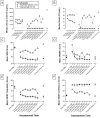Pilot study of the 5-HT2AR agonist psilocybin in the treatment of tobacco addiction
- PMID: 25213996
- PMCID: PMC4286320
- DOI: 10.1177/0269881114548296
Pilot study of the 5-HT2AR agonist psilocybin in the treatment of tobacco addiction
Abstract
Despite suggestive early findings on the therapeutic use of hallucinogens in the treatment of substance use disorders, rigorous follow-up has not been conducted. To determine the safety and feasibility of psilocybin as an adjunct to tobacco smoking cessation treatment we conducted an open-label pilot study administering moderate (20 mg/70 kg) and high (30 mg/70 kg) doses of psilocybin within a structured 15-week smoking cessation treatment protocol. Participants were 15 psychiatrically healthy nicotine-dependent smokers (10 males; mean age of 51 years), with a mean of six previous lifetime quit attempts, and smoking a mean of 19 cigarettes per day for a mean of 31 years at intake. Biomarkers assessing smoking status, and self-report measures of smoking behavior demonstrated that 12 of 15 participants (80%) showed seven-day point prevalence abstinence at 6-month follow-up. The observed smoking cessation rate substantially exceeds rates commonly reported for other behavioral and/or pharmacological therapies (typically <35%). Although the open-label design does not allow for definitive conclusions regarding the efficacy of psilocybin, these findings suggest psilocybin may be a potentially efficacious adjunct to current smoking cessation treatment models. The present study illustrates a framework for future research on the efficacy and mechanisms of hallucinogen-facilitated treatment of addiction.
Keywords: Hallucinogen; addiction; nicotine; psilocybin; psychedelic; smoking cessation; tobacco.
© The Author(s) 2014.
Figures


Comment in
-
Back to the future: a return to psychedelic treatment models for addiction.J Psychopharmacol. 2014 Nov;28(11):981-2. doi: 10.1177/0269881114550935. Epub 2014 Sep 24. J Psychopharmacol. 2014. PMID: 25253275 No abstract available.
References
-
- Benowitz NL, Jacob P, III, Ahijevych K, et al. Biochemical verification of tobacco use and cessation. Nicotine Tob Res. 2002;4(2):149–159. - PubMed
-
- Bogenschutz MP, Pommy JM. Therapeutic mechanisms of classic hallucinogens in the treatment of addictions: From indirect evidence to testable hypotheses. Drug Test Anal. 2012;4(7–8):543–555. - PubMed
-
- Bowen WT, Soskin RA, Chotlos JW. Lysergic acid diethylamide as a variable in the hospital treatment of alcoholism: a follow-up study. J Nerv Ment Dis. 1970;150:111–118. - PubMed
-
- Bramer SL, Kallungal BA. Clinical considerations in study designs that use cotinine as a biomarker. Biomarkers. 2003;8(3–4):187–203. - PubMed
-
- Cahill K, Stevens S, Lancaster T. Pharmacological Treatments for Smoking Cessation. JAMA. 2014;311(2):193–194. - PubMed
Publication types
MeSH terms
Substances
Grants and funding
LinkOut - more resources
Full Text Sources
Other Literature Sources
Medical

